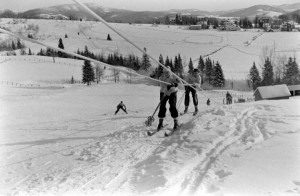
65 Years Ago
SKIERS WANT UPGRADE FROM ROPE TOW. The average skier skis only seven times per winter, according to a Colorado poll. He would rather get the most possible downhill skiing than concentrate on improving his form. Most skiers would willingly trade two rope tow tickets for a ticket on a chairlift or T-bar. -- Elizabeth Forbes, Aspen, February 1, 1949 SKI Magazine.
HOLLYWOOD INVADES ASPEN. The Gary Coopers of Hollywood have purchased 30 acres of land in Aspen, and plan to build in the springtime. – February 15, 1949 SKI Magazine.
WHEN SKI INJURY WAS A FRACTURE OR SPRAIN. Of 4,428 injuries reported last season to the National Ski Patrol, 48 percent were sprains and 23 percent were fractures, according to Minot Dole. Of the fractures, 56 percent were of the ankle, 28 percent of the lower leg and other parts of the anatomy. -- February 1, 1949 SKI Magazine.
60 Years Ago
POPULAR GEAR. There is a growing tendency toward edges that are set slightly out from the edge of the ski, and for an adjustable-length pole that can be used for various purposes. Stein Eriksen has produced a slalom ski which has tiny ridges instead of the standard groove on the running surface, and is concave at the bend of the ski. – Charles M. Dudley, 1954 American Ski Annual and Skiing Journal.
55 Years Ago
LEG PLASTER INSCRIPTION CHALLENGE. Writing on a cast is a tricky business when you’re not well acquainted with the owner of the broken leg. “I’d like to fall for you,” or “The next time you’re casting, give me a break,” or “Set ‘em up in the other alley,” are all acceptable. Try to avoid sentimentality, and don’t put anything in writing that you’ll be sorry for later. If you like the person, you could put a return address on the shin. -- Art Buchwald, NY Herald Tribune, February 26, 1959.
HEAD OVERCOME WITH ORDERS. The Head Ski Company reports orders from retailers running far ahead of production, even though the Baltimore plant is operating on an 18-hour-per-day schedule. -- February 1959 SKI Magazine.
25 Years Ago
THE MYTH OF EXPENSIVE SKIING. Nobody is forcing skiers to pay high prices. There has always been a ski-cheap option. But dozens of ski areas, which kept their prices down by holding back on snowmaking and grooming, went bust because few skiers wanted what they were offering. Meanwhile technologically advanced resorts, which boosted their grooming and snowmaking and paid for the improvements by escalating ticket prices, have been mobbed. – Morten Lund, January 1989, Snow Country Magazine.
COLLISION ALERT! Collisions have become the number-one cause of injury in skiing. Unless we can convince skiers that good skiing is good turning, we’re in trouble. We may get state laws requiring a license before you can ski on your own. – Linda Meyers Tikalski, former racer, skiing risk management consultant, January 1989 Snow Country Magazine.
35 Years Ago
WHEN CROSS COUNTRY WAS COLOSSAL. The 1979-80 SKI Magazine Guide to Cross Country Skiing bulked at 186 pages, including a 48-page guide to more than 400 places for ski touring, reviews of 23 cross-country books and 20 films and videos, and backed by more than 100 advertisers. The Editors previewed the 1980 Nordic events at Lake Placid, and the season’s new equipment and fashion. Featured was an article on the battle between snowmobilers and cross country skiers across the nation.
15 Years Ago
TV RATINGS WEAK. Gian Franco Kasper has just replaced the legendary Marc Hodler as President of FIS -- the International Skiing Federation. “What is the greatest challenge you will face? Kasper was asked. “Competition from other sports for television time, and sponsor-created events that are here one year, gone the next. Genuine ski racing now competes with extreme snowboarding on Mt. Everest, or a freestyle event inside a tent in Paris. U.S. events used to generate more revenues for the FIS, but now the size of the European television audience for ski racing is ten times larger than in America. -- Kasper interviewed by John Fry in November 1998 Ski Area Management.
Category:
Snapshots
